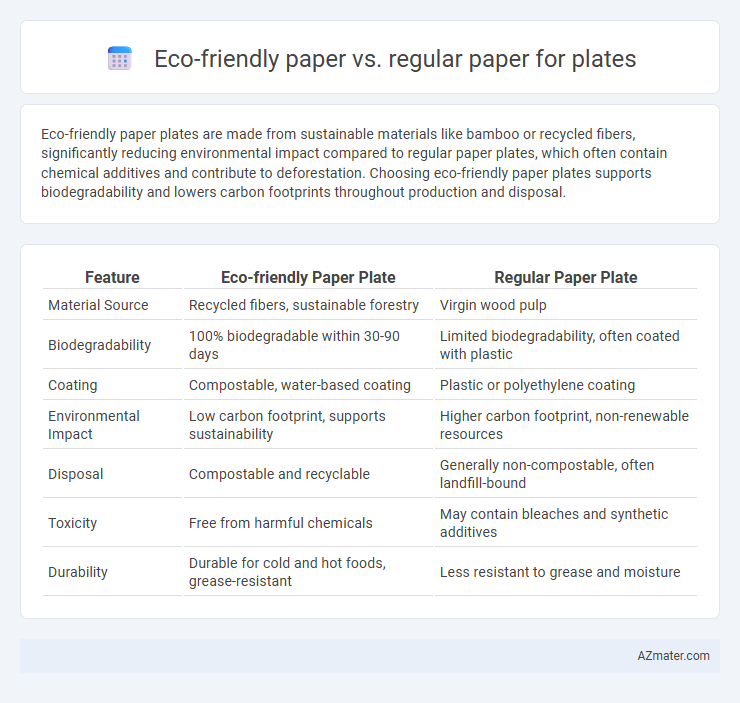Eco-friendly paper plates are made from sustainable materials like bamboo or recycled fibers, significantly reducing environmental impact compared to regular paper plates, which often contain chemical additives and contribute to deforestation. Choosing eco-friendly paper plates supports biodegradability and lowers carbon footprints throughout production and disposal.
Table of Comparison
| Feature | Eco-friendly Paper Plate | Regular Paper Plate |
|---|---|---|
| Material Source | Recycled fibers, sustainable forestry | Virgin wood pulp |
| Biodegradability | 100% biodegradable within 30-90 days | Limited biodegradability, often coated with plastic |
| Coating | Compostable, water-based coating | Plastic or polyethylene coating |
| Environmental Impact | Low carbon footprint, supports sustainability | Higher carbon footprint, non-renewable resources |
| Disposal | Compostable and recyclable | Generally non-compostable, often landfill-bound |
| Toxicity | Free from harmful chemicals | May contain bleaches and synthetic additives |
| Durability | Durable for cold and hot foods, grease-resistant | Less resistant to grease and moisture |
Introduction: The Battle of Plate Materials
Eco-friendly paper plates are crafted from renewable resources like bamboo, sugarcane bagasse, or recycled fibers, reducing environmental impact through compostability and lower carbon footprints compared to regular paper plates. Regular paper plates typically rely on virgin wood pulp and often contain polyethylene coatings, which hinder biodegradability and contribute to plastic waste. The choice between eco-friendly and regular paper plates significantly influences sustainability efforts in disposable tableware consumption.
What Makes Paper Plates Eco-Friendly?
Eco-friendly paper plates are made from renewable resources such as bamboo, sugarcane bagasse, or recycled fibers, reducing reliance on virgin wood pulp and minimizing deforestation. They often utilize biodegradable and compostable materials, ensuring they break down naturally without releasing harmful chemicals into the environment. Production processes for eco-friendly plates prioritize lower energy consumption, water usage, and the elimination of toxic dyes or coatings, making them a sustainable alternative to regular paper plates.
Composition: Eco-Friendly vs Regular Paper Plates
Eco-friendly paper plates are typically composed of biodegradable materials such as recycled paper fibers, sugarcane bagasse, or bamboo pulp, ensuring minimal environmental impact during decomposition. Regular paper plates often contain bleached wood pulp combined with chemical coatings like polyethylene or plastics to increase durability and moisture resistance, which hinders biodegradability. The natural fibers and absence of synthetic additives in eco-friendly plates enhance sustainability efforts while reducing landfill waste compared to conventional paper plate compositions.
Manufacturing Process and Environmental Impact
Eco-friendly paper plates are produced using sustainable materials such as bamboo, sugarcane bagasse, or recycled fibers, which require less water and energy during manufacturing compared to conventional wood pulp used in regular paper plates. The manufacturing process of eco-friendly paper emphasizes chemical-free pulping and minimal use of bleaches, reducing harmful emissions and water pollution. Regular paper plates often involve high energy consumption, chemical bleaching, and deforestation, resulting in greater carbon footprint and landfill waste.
Biodegradability and Compostability
Eco-friendly paper plates, made from natural fibers such as sugarcane bagasse or bamboo, exhibit superior biodegradability and compostability compared to regular paper plates coated with plastic or wax. These sustainable plates break down rapidly in industrial composting facilities within 30 to 90 days, minimizing landfill waste and reducing environmental impact. In contrast, regular paper plates often resist decomposition due to synthetic coatings, contributing to prolonged pollution and resource inefficiency.
Chemical Additives and Health Concerns
Eco-friendly paper plates typically contain fewer chemical additives such as chlorine, dyes, and bleaching agents compared to regular paper plates, reducing the risk of harmful substances leaching into food. Regular paper plates often use synthetic coatings and additives that can release volatile organic compounds (VOCs) or toxic residues during use, raising health concerns. Choosing eco-friendly options minimizes exposure to hazardous chemicals and supports safer, non-toxic dining alternatives.
Cost Comparison: Eco-Friendly vs Regular Plates
Eco-friendly paper plates typically cost 15-30% more than regular paper plates due to sustainable materials and manufacturing processes. Bulk purchasing often reduces the price gap, making biodegradable options more competitive for large-scale use. Long-term savings may also arise from lower environmental disposal fees and positive brand impact.
Consumer Awareness and Market Trends
Eco-friendly paper plates, made from recycled fibers or sustainable sources like bamboo and sugarcane bagasse, are gaining significant traction among environmentally conscious consumers seeking biodegradable and compostable alternatives to regular paper plates. Market trends indicate a rising demand driven by increasing consumer awareness of plastic pollution and deforestation caused by traditional paper production, resulting in a shift towards products featuring FSC certification and reduced chemical processing. Retail data reveals that eco-friendly paper plates often command a premium price due to their sustainable attributes, as manufacturers respond to evolving regulations and the preference for green packaging within the foodservice and hospitality industries.
Real-World Performance: Strength and Durability
Eco-friendly paper plates, often made from recycled fibers or sustainable materials like bagasse, exhibit comparable or superior strength and durability to regular paper plates due to advanced bonding techniques and natural fiber reinforcement. These plates resist moisture and grease effectively, maintaining structural integrity during meals without excessive bending or tearing. Regular paper plates, typically coated with plastic or wax, may offer short-term stiffness but often lack biodegradability and can weaken under prolonged exposure to liquids, impacting real-world usability.
Conclusion: Choosing the Greener Plate Option
Selecting eco-friendly paper plates significantly reduces environmental impact through the use of biodegradable materials and sustainable production processes. These plates minimize landfill waste and lower carbon footprints compared to regular paper plates made from non-recycled fibers and chemical treatments. Opting for greener plate options supports resource conservation and promotes long-term ecological balance.

Infographic: Eco-friendly paper vs Regular paper for Plate
 azmater.com
azmater.com